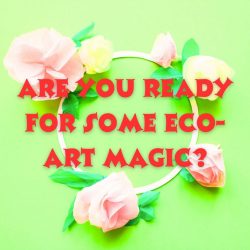Umweltkunst: Ein innovativer Ansatz zur Umweltkommunikation?
In einer Welt, in der Umwelt- und Klimaverschlechterung eine globale Bedrohung darstellen, von der vor allem einkommensschwache und/oder farbige Bevölkerungsgruppen betroffen sind, ist die Suche nach wirksamen Methoden der Umweltkommunikation von entscheidender Bedeutung. Eine kürzlich durchgeführte Studie untersuchte einen innovativen Ansatz: die Verwendung von Kunst zur Vermittlung von Umweltdaten. – Im Folgenden finden Sie eine Zusammenfassung des Artikels:
„Vermittlung von Umweltdaten durch Kunst: die Rolle von Emotionen und Erinnerung bei der Erweckung von Umwelthandlungen“.
Kaufmann, D.B., Palawat, K., Sandhaus, S. et al. Kommunikation von Umweltdaten durch Kunst: die Rolle von Emotionen und Erinnerung bei der Hervorrufung von Umwelthandlungen. Humanit Soc Sci Commun 10, 940 (2023). https://doi.org/10.1057/s41599-023-02459-3
Ein neuer Ansatz für die Umweltkommunikation
Der Artikel untersucht die Wirksamkeit von Umweltkunst bei der Vermittlung komplexer wissenschaftlicher Daten und ihre Auswirkungen auf die emotionale Wahrnehmung und Erinnerung der Betrachter. Die Autoren betonen die Notwendigkeit innovativer Ansätze in der Umweltkommunikation, um überholte Meinungen über wissenschaftliches Wissen zu überwinden, individuelle Wert-Handlungs-Gefälle in Frage zu stellen und mehr Menschen für die Wissenschaft zu begeistern. Im Rahmen eines gemeinschaftlich durchgeführten Wissenschaftsprojekts wurde eine Fall-Kontroll-Studie durchgeführt, um zu untersuchen, ob die Art der Datenvisualisierung das wissenschaftliche Lernen, die emotionale Reaktion, die Verhaltensergebnisse und die Umwelthandlungen der Teilnehmer beeinflussen kann. Es wurden zwei neue Arten der Datenweitergabe entwickelt, um die Daten der Regenwassersammlung auf den Dächern der Gemeinde zu vermitteln: (1) eine statische Broschüre und (2) eine interaktive Umweltkunstinstallation namens „Ripple Effect“, die mit einer Broschüre kombiniert wurde.

Die Ergebnisse zeigen, dass Umweltkunst nicht nur in der Lage ist, komplexe wissenschaftliche Daten wirkungsvoll zu vermitteln, sondern auch Hindernisse für die traditionelle Wissenschaftskommunikation zu überwinden, indem sie die Gefühle und das Gedächtnis der Menschen beeinflusst. Dies erhöht die Wahrscheinlichkeit, dass sie ihr Verhalten ändern oder neue Maßnahmen in ihrer Umgebung ergreifen. Diese Ergebnisse stehen im Einklang mit der umweltpsychologischen Literatur. Darüber hinaus ist es den Autoren gelungen, die Rolle des Gedächtnisses und die langfristigen Auswirkungen von Umweltkunst auf umweltfreundliches Verhalten zu erfassen.
Die Forschungsergebnisse deuten darauf hin, dass Umweltkunst eine wichtige Rolle bei der Behandlung sozialer, kultureller und politischer Fragen spielen kann, indem sie die Menschen intuitiv mit der natürlichen Umwelt verbindet und mehrdimensionale Räume schafft, in denen die Menschen eine Vielzahl von Sinneserfahrungen machen können. Dies kann dazu beitragen, die Kluft zwischen Werten und Handlungen zu schließen und eine wichtige Rolle bei der Förderung der umweltbezogenen Gesundheitserziehung spielen.
Insgesamt zeigen die Ergebnisse des Artikels, dass innovative Formate in der Umweltkommunikation geschaffen werden können, um Umwelt und Gesundheit effektiv zu vermitteln und positive Umweltauswirkungen zu fördern. Die Autoren betonen die Bedeutung der Umweltkunst als wirkungsvolles Instrument zur Vermittlung komplexer wissenschaftlicher Daten auf eine Weise, die die Menschen emotional berührt und ihr Verhalten langfristig beeinflusst.
Bildrechte
Copyright masalskaya via Canva
Urheberrecht SolStock via Canva
Environmental art: An innovative approach to environmental communication?
In a world where environmental and climate degradation is a global threat that particularly affects low-income and/or communities of color, finding effective methods of environmental communication is critical. A recent study explored an innovative approach: using art to communicate environmental data. – Below is a summary of the article:„Communicating environmental data through art: the role of emotions and memories in evoking environmental action“.Kaufmann, D.B., Palawat, K., Sandhaus, S. et al. Communicating environmental data through art: the role of emotion and memory in triggering environmental action Humanit Soc Sci Commun 10, 940 (2023). https://doi.org/10.1057/s41599-023-02459-3
A new approach to environmental communication
The article examines the effectiveness of environmental art in communicating complex scientific data and its impact on the emotional perception and memory of viewers. The authors emphasize the need for innovative approaches in environmental communication to overcome outdated ideas about scientific knowledge, overcome individual value-action gaps, and engage more people in science. As part of a collaborative science project, a case-control study was conducted to investigate whether the type of data visualization can influence participants‘ science learning, emotional response, behavioral outcomes, and environmental actions. Two new types of data sharing were developed to communicate the community’s rooftop rainwater collection data: (1) a static brochure and (2) an interactive environmental art installation called „Ripple Effect“ that was combined with a brochure.

The results show that environmental art is not only able to effectively communicate complex scientific data, but also to overcome the barriers of traditional science communication by influencing people’s emotions and memory. This increases the likelihood that they will change their behavior or take new actions in their environment. These results are in line with the environmental psychology literature. In addition, the authors have succeeded in capturing the role of memory and the long-term effects of environmental art on pro-environmental behavior.The research findings suggest that environmental art can play an important role in addressing social, cultural and political issues by intuitively connecting people to the natural environment and creating multidimensional spaces where people can have a variety of sensory experiences. This can help bridge the gap between values and actions and play an important role in promoting environmental health education.Overall, the results of the article show that innovative formats in environmental communication can be created to effectively communicate environment and health and promote positive environmental impacts. The authors emphasize the importance of environmental art as an effective tool for communicating complex scientific data in a way that touches people emotionally and influences their behavior in the long term.
Photos:
Copyright masalskaya via Canva
Copyright SolStock via Canva








